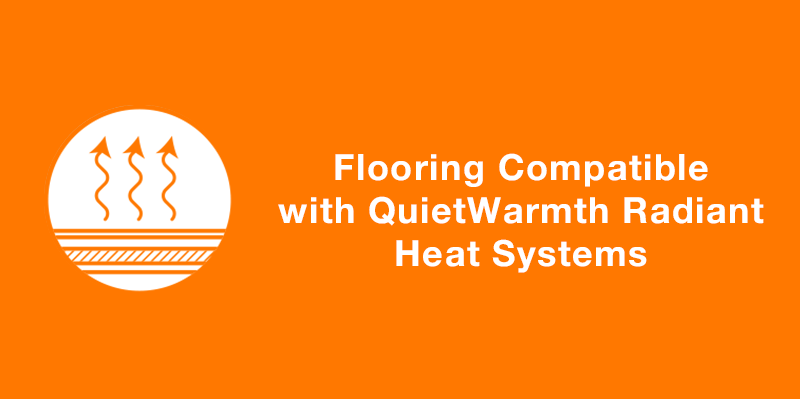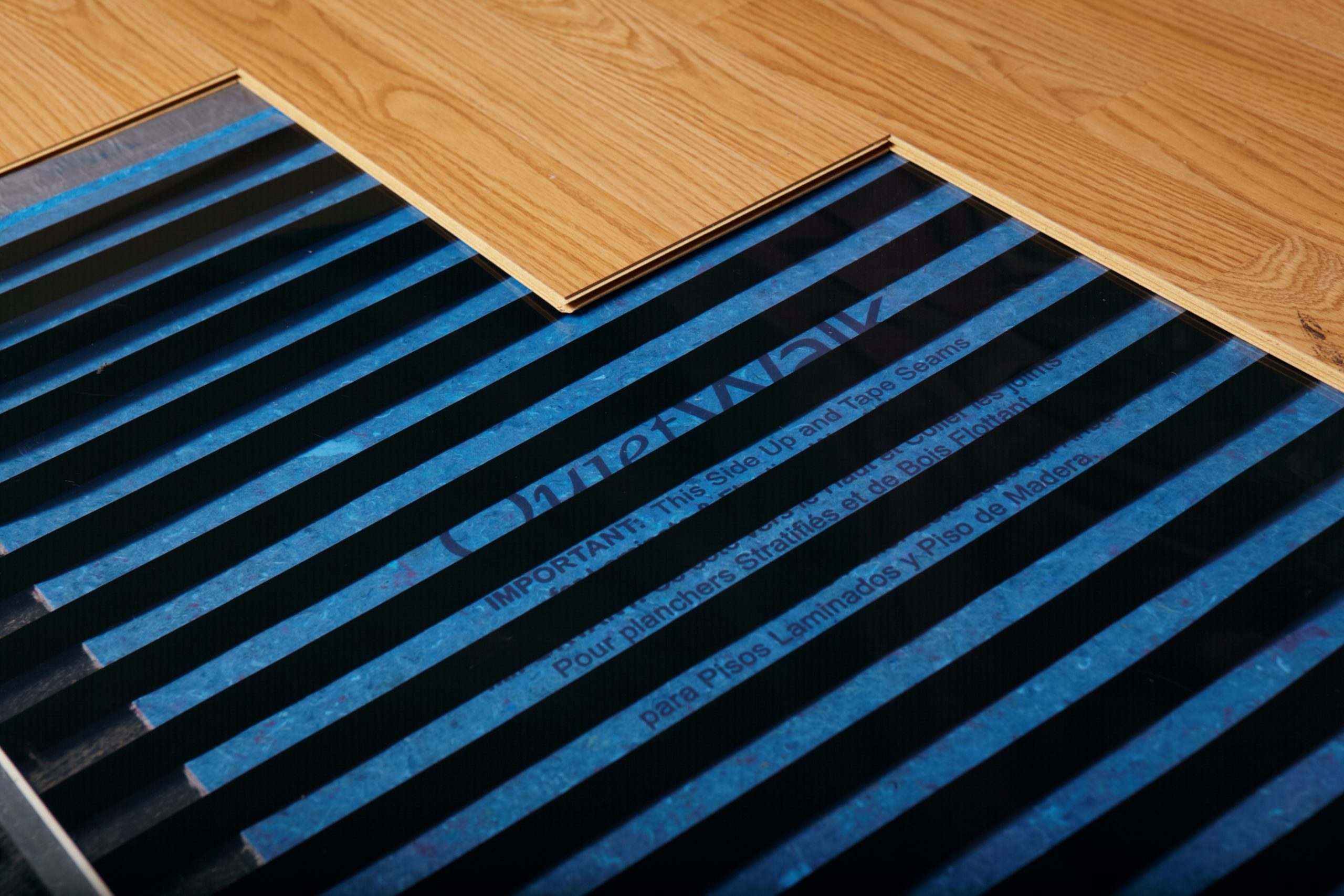Flooring Compatible with QuietWarmth Radiant Heating Systems.

With all of the different flooring brands out there, it can be hard to tell if your flooring is compatible with QuietWarmth Radiant Heating Systems. The good news is most kinds of flooring are compatible! We will cover some common flooring brands and how you can find out if your flooring is compatible if not listed in the article.

QuietWarmth Radiant Heating Systems by Brand of Flooring
Different brands have different installation instructions when it comes to radiant heating. We will cover some of the common flooring brands below. If you do not see your brand of flooring don’t worry. Later in the article, we will discuss QuietWarmth’s compatibility by type of flooring.
Does LifeProof work with QuietWarmth?
Yes, LifeProof is compatible with QuietWarmth. The flooring temperature must not exceed 85 degrees Fahrenheit. QuietWarmth mats are designed not to be able to exceed 85 degrees. Unlike wire mesh mats, QuietWarmth’s ink mats are thinner than a credit card so you will not have to worry about wires showing through the flooring. However, you will need to create a channel for the lead wires either in an underlayment beneath, or the subfloor.
Does SmartCore work with QuietWarmth?
Yes, SmartCore will work with QuietWarmth. Like LifeProof, SmartCore also has a maximum temperature limit of 85 degrees Fahrenheit. They also require the use of an in-floor heating sensor to accurately monitor the temperature of your floors. All of QuietWarmth’s thermostats come with an in-floor sensor included.
QuietWarmth Heating Systems by Types of Flooring
If the flooring you are planning on installing was not listed above, we are going to discuss QuietWarmth’s compatibility based on the flooring type being installed.
Luxury Vinyl Flooring
Vinyl flooring has come along and is becoming more and more popular. While its conduction is not as good as tile, the planks are usually thinner and still transfer an effective amount of heat through. With vinyl, the most important factor to look for is the manufacturer’s temperature limit. Most temperature limits are around 85 degrees. This is why we designed QuietWarmth to have a maximum heat output of 85 degrees. Usually, vinyl planks are installed in a floating floor design. QuietWarmth for floating floors does not require any extra self levelers or mortars, keeping the installation as simple as possible.
Laminate Flooring
When installing radiant heating under laminate, moisture must be kept in mind. If moisture affects the laminate flooring while changing temperatures, it can cause warping and bending of the planks. If you’re installing over a concrete subfloor, a 6-mil vapor barrier is recommended to eliminate any moisture from reaching your floors. The ideal layout for laminate flooring is subfloor, 6-mil vapor barrier for concrete, QuietWalk underlayment, QuietWarmth radiant heating mats.
Ceramic, Porcelain, and Stone Tile
Stone and Tile are the ideal types of flooring to be used with all radiant heating systems. They do not expand nor contract with heat easily giving them higher maximum temperatures. Being particularly resistant to warping or cracking, make ceramic, porcelain, and stone tiles the best choice for radiant heating floor coverings. QuietWarmth Peel and Stick makes installation easier than ever. The mats simply stick to the subfloor and allow the tiling to be installed over the same day. The radiant heat film is also integrated with a waterproof anti-fracture membrane which helps isolate cracks up to 3/8-inch wide.
Woods
Hardwood
Installing hardwood over a radiant heating system can be tricky, but also extremely comfortable if executed correctly. Hardwoods can be affected fairly easily by sudden temperature changes. This makes it extremely important to raise the floor’s heating temperature gradually being careful not to damage the flooring. Factors like the type of wood, sawn style, and acclimation all play a role in the hardwood’s ability to work with radiant heating systems. MacDonald Hardwood’s blog goes into deeper detail about these factors.
Keep in mind nail-down hardwood installations will not work with QuietWarmth as the nails will puncture the film, disrupting the connection of the mat. QuietWarmth Peel and Stick is suitable for glue-down applications of hardwood flooring. If you have pre-existing hardwood floors and have access to the floor joists, QuietWarmth Retrofit Radiant heating mats can be installed in between your floor’s joists.
Engineered Hardwoods
A wood flooring option that is better suited to be used with radiant heating systems is engineered hardwood flooring. The arrangement of thin layers of solid wood or fiberboard. As a result of multi-layer construction, the planks are more dimensionally stable, with less room for movement, allowing the flooring to withstand changes in temperature and humidity much better than traditional hardwood floors. The ability to float most engineered hardwoods makes them more ideal for installation over concrete subfloors.
Although engineered hardwood flooring is more compatible than standard hardwood, the adhesives and wood species will still play an important role. Since Engineered Hardwoods can be floated or glued, they are compatible with all three types of QuietWarmth. QuietWarmth for floating floors, QuietWarmth Peel and Stick, or QuietWarmth Retrofit.
Carpet
Carpet is a suitable choice for radiant floor heating systems. However, it is not a quality conductor of heat. In consequence, your feet will stay warm but it will be more difficult to begin to heat the entire room. QuietWarmth cannot be installed directly underneath carpets. However, QuietWarmth retrofit can be installed underneath the floor in between the joists as stated before. The benefit of installing Retrofit mats is the ability to install radiant heat at any time without ripping up any of your existing flooring.
Warranties
Some flooring manufacturers will void the warranty if you install radiant heating underneath. It is not always because the flooring is incompatible, but because they do not want any extra potential factors of creating flooring failure. If you are concerned with the warranty of your flooring being voided with the addition of radiant heat, it is best to contact the flooring manufacturer to get more information.
Join Our Newsletter
You are about to install your new flooring. As you lay the first plank you realize that
